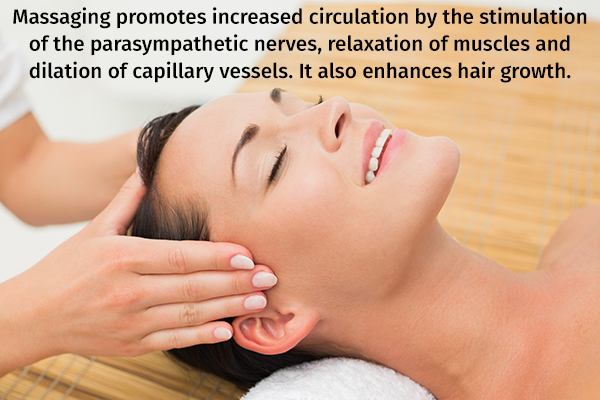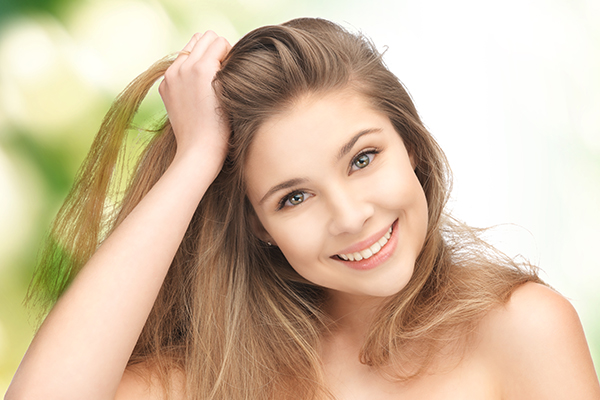In this article:
Hair has a growth cycle, which is divided into four phases: anagen, catagen, telogen, and exogen. The anagen phase is when the hair grows to its full length and strength. The duration of this phase depends upon the nourishment of the hair follicles and genetic factors.

Hair follicles derive their nourishment from the blood, which delivers oxygen and hair-building nutrients. At the base of each hair follicle lies a clump of cells called papillae that is highly vascularized, which means it is connected to a dense network of blood vessels.
Proper blood circulation in the scalp ensures a steady blood supply to the hair follicles to sustain a longer anagen phase, allowing the hair to grow longer and stronger.
Conversely, poor blood circulation means inadequate nutrition to the hair follicles, which can make them dormant, cutting short the anagen phase. The lack of nutrients and oxygen does not allow the follicles to function properly in terms of hair building, thus producing short, brittle hair strands.
This article discusses various methods of increasing blood flow to your scalp to maintain hair health.
Ways to Increase Blood Flow to the Scalp
Here are some things you can do to boost scalp circulation and reap its benefits.
1. Massage your scalp

The papillae at the base of the hair follicles are enriched with blood vessels that supply oxygen and nutrients needed for hair growth. The better the blood circulation in the scalp, the healthier the hair.
One of the best ways to stimulate blood circulation in the head is through a scalp massage. All you have to do is to knead your scalp with your fingers, applying gentle pressure. This topical stimulation opens up and activates the blood vessels to supply more oxygen and nutrients to the hair follicles, enhance metabolism in the papillae, and facilitate better elimination of waste from the hair follicles.
Research shows that massaging promotes increased circulation by the stimulation of the parasympathetic nerves, relaxation of the muscles, and dilation of the capillary vessels. (1) It also enhances hair growth. (2)
How to do it:
For a proper massage session, use lukewarm oils. There are plenty of oils you can use such as coconut oil, olive oil, jojoba oil, almond oil, brahmi oil, bhringraj oil, sesame seed oil, Moroccan argan oil, sunflower seed oil, and castor oil.
You can prepare oil blends by mixing any two of the above-mentioned oils or by mixing any one of them with an essential oil.
Some of the best essential oils for improving blood circulation in the scalp and promoting overall hair growth are rosemary, lavender, cedar wood, thyme, and peppermint. (3)(4) These aromatic oils are also credited with antimicrobial properties that can help keep your scalp infection-free.
Bear in mind that essential oils are very strong at their original concentration and need to be diluted in a carrier oil before topical use.
- To prepare an oil blend using an essential oil, mix a few drops of it in any carrier oil of your choice.
- Warm the oil/oil blend a little and massage it in your scalp. Apply it also to your hair roots and hair strands.
- Let it sit for at least a few hours.
- Shampoo and condition your hair.
2. Bust your stress
Several studies have shown that psychological stress decreases blood circulation in the blood vessels by an endothelium-dependent mechanism and increases the risk of myocardial infarction or a heart attack. (5)
Therefore, stress management is important to maintain healthy blood circulation within your scalp and body.
How to do it:
- Aromatherapy with essential oils such as peppermint, sandalwood, jasmine, rose, and lavender essential oils can help reduce stress. (6)(7) All these essential oils give off a soothing aroma that relaxes all your senses. They also exhibit a wide array of other medicinal properties that can help your body heal in numerous ways. You can light scented candles that contain essential oils to release their therapeutic vapors in your environment. You can also mix a few drops of your preferred essential oil in your bathwater and then soak in it. Another way is to use a diffuser to release the vapors of essential oils in your room.
- Exercise every day for at least 30 minutes. You can make your own exercise regimen by combining cardio exercises and strength training. If you are new to it, you may begin with simple exercises such as bicycling and jogging. You can also add meditation to your routine.
- Every adult needs at least 6–7 hours of restful sleep regularly for optimal health, but oversleeping (more than 8 hours in a day) can have the opposite effect.
3. Practice yoga

The following yoga poses or asanas can increase blood flow to your scalp for proper hair follicle function and healthy hair growth. (8)
- Downward dog
- Standing forward pose
- Inversion pose
- Legs up the wall
- Shoulder stand
Pranayama is not a yoga pose but a breathing technique that forms the crux of all yoga poses. It involves taking in a long breath, retaining it in your body, and then slowly releasing it. This form of deep breathing opens up your nostrils and leads to a better flow of oxygen throughout the body, (9) and it also releases pent-up stress.
4. Eliminate scalp buildup
Scalp buildup refers to the organic and inorganic wastes or residues that accumulate on the scalp over time. These impurities trickle down into the hair follicles and clog them.
The clogged hair follicles are unable to receive proper blood flow under the skin and eventually shrink, thus producing short, weak hair. Moreover, the buildup of dead skin flakes and excess sebum on the scalp provides fodder for infection-causing microbes, thus leading to scalp infections.
The main reasons for the gradual accumulation of these substances on your head are:
- Using hair products that contain sulfates and silicones, which get stuck on your hair or scalp
- Overuse of hair products that leave behind residue or dry out your scalp
- Frequent exposure to airborne pollutants
- Negligent scalp/hair hygiene, which means going days without a hair wash or not washing your hair properly
To avoid scalp buildup:
- Wash your hair every 1–2 days if you have an oily scalp and every 3–4 days if you have dry scalp.
- Wash your hair and scalp with a clarifying shampoo once a month for a deep cleanse.
- Use exfoliating hair products with mild alpha-hydroxy acids that dislodge and remove the impurities settled on the scalp.
- Prepare your own hair masks for exfoliation using yogurt, apple cider vinegar, and/or honey, which can scrub away the dead skin cells, grime, excess sebum, and product residue on the scalp.
- When buying hair products, go for those that are free of sulfates, parabens, silicones, formaldehyde, and alcohol.
5. Consume nutrients that increase blood flow

Niacin, or vitamin B3, has been shown to increase cerebral blood flow, (10) improve the function of the cells that make up blood vessels, and promote the formation of new blood vessels. (11) Some of the richest dietary sources of niacin are mushrooms, peas, peanuts, avocados, fish, turkey, chicken, and beef.
Dark chocolate is rich in flavanols, which have also been shown to increase blood flow to the head. (12)
Sometimes, platelet aggregation can lead to blood flow obstruction, and turmeric can help prevent that. This effect is attributed to curcumin, which is the main bioactive compound found in turmeric. (13)
Besides these, vitamin A, zinc, iron, beetroot, cayenne pepper, antioxidant berries, omega-3 fatty acids, spinach, garlic, and protein are great for hair health as well.
It is important to note that such nutrients do not direct the blood flow to your scalp and specifically to the hair papillae. These have simply been shown to improve blood circulation to the head or to the whole body in general. Therefore, consume a balanced diet to maintain optimum blood circulation.
Some Anecdotal Remedies
There are some interesting anecdotal remedies in the form of hair oils and masks that are popularly suggested for increasing blood circulation in the scalp, but they do not have any scientific backing.
Here are a few remedies that you can try:
- Herbal hair masks containing ginseng, ashwagandha, ginger, licorice, fenugreek, hibiscus, grapeseed oil, and camphor may promote blood supply in the scalp. All of these herbs are available in powdered form.
- Onion rinse or paste helps improve blood circulation in the scalp to facilitate better hair growth.
- Gently combing your hair with a soft-bristled hairbrush inadvertently massages the scalp. This topical stimulation activates the underlying capillaries to increase blood flow to the scalp. However, the compact bristles can get stuck into your hair knots and pull at your hair roots while brushing, which can lead to hair weakening or breakage. It is therefore important to detangle your hair with a wide-tooth comb before brushing them. If your hair is dense, curly, or unruly, divide them into sections and then comb each lock of hair slowly and gently. Forceful or vigorous hair brushing can damage your hair cuticle (outermost layer of the hair) and strain your hair roots.
- Doing scalp exercises such as eyebrow lifts may help direct blood flow to your scalp.
Most-Asked Questions About Blood Circulation in the Scalp

What are the signs of poor blood circulation in the scalp?
As mentioned, poor blood circulation in the scalp leads to poor hair growth. Thus, you can tell that your scalp is not receiving enough blood by the nature of your hair. Undernourished hair follicles tend to produce hair that is dry, dull, and weak or prone to breakage.
Your scalp or hair may give off a foul odor if you are prone to scalp buildup. Scalp build-up may not be caused by poor blood circulation in the scalp but can definitely lead to it by clogging your hair follicles over time.
In severe cases, you might also experience gradual thinning of hair and loss in its density.
Can low-level laser therapy boost blood circulation to the scalp?
The use of low-level laser on the scalp is thought to stimulate the release of nitric oxide from the cells. This increase in nitric oxide levels can induce vasodilation, thus boosting blood circulation.
Some physicians disregard the use of low-level laser therapy, while others support its use for the treatment of androgenic alopecia. It is also suggested that low-level laser therapy can support wound healing and can boost hair growth after a hair transplant.
Do cold showers increase blood circulation in the scalp?
It is often recommended to take cold showers to increase blood circulation in the scalp, but there are no studies to back this claim. In fact, there are contradictory claims that suggest that cold showers trigger hypertension by constricting the blood vessels and thereby reduce blood flow to the scalp.
Final Word
A healthy scalp means good hair growth and no overgrowth of microbial colonies, and this is influenced by the blood flow in the scalp. Your scalp, in a way, feeds on the nourishment provided by the circulation.
The influx of the nutrients helps the hair cells to function optimally and produce strong and long hair, whereas the microbe-fighting cells keep your scalp free of infections.
There are multiple ways to increase blood flow to your head. You can try any of them, but it’s best to combine different hair care remedies for maximum benefits. Moreover, it’s important to use these remedies and tips as part of a wholesome and consistent hair-care routine, coupled with an overall healthy lifestyle and nutritious diet.
- Was this article helpful?
- YES, THANKS!NOT REALLY


